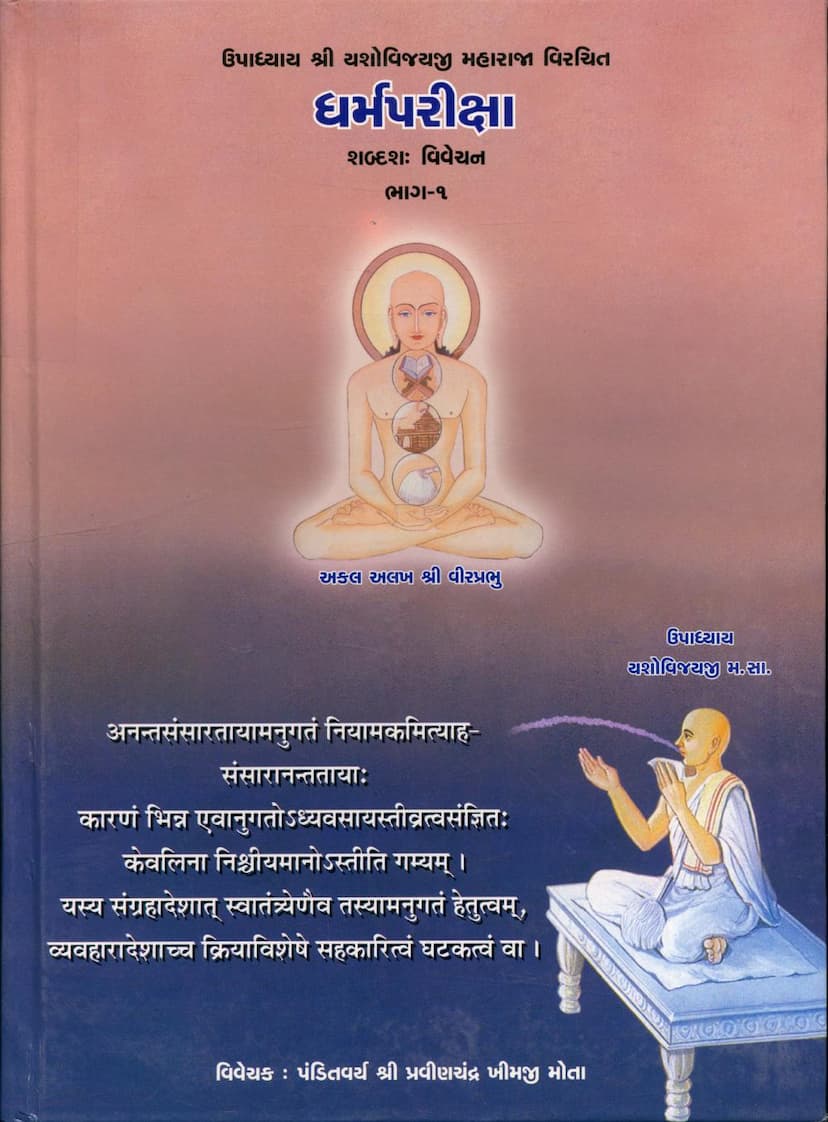Dharm Pariksha Part 01
Added to library: September 1, 2025

Summary
This Jain text, "Dharm Pariksha Part 01" by Upadhyay Shri Yashovijayji Maharaj, with a commentary by Panditvar Shri Pravinchandra Khimji Mota, is a profound exploration of Dharma (righteousness, duty, and religious path) through critical examination and analysis. Published by Gitarth Ganga, the book delves into the nuances of Jain philosophy, aiming to clarify and guide spiritual seekers.
The text emphasizes the importance of Dharm Pariksha (examination of Dharma), defining it as a process of judiciously and impartially evaluating principles and practices based on Jin Vachana (teachings of the Jinas), logic, and experience, free from attachment, aversion, and bias. The commentary highlights the necessity of a middle path (madhyastha) in this examination, stating that adherence to any particular doctrine without critical evaluation is flawed.
Key themes and concepts discussed in the initial chapters and highlighted in the compilation include:
- The Nature of Dharma Pariksha: It is presented as an effort to discern truth without prejudice, emphasizing impartiality and adherence to the Jinas' teachings, logic, and personal experience.
- The Role of the Examiner: The text outlines the qualities of a proper examiner, implying the need for knowledge, balanced perspective, and freedom from personal biases.
- Consequences of Deviant Teachings (Usutra Bhashan): The book discusses how straying from the true teachings, even in minor ways, can lead to negative consequences and prolonged entanglement in the cycle of birth and death (ananta sansar). The severity of these consequences is linked to the intensity of one's adhyavasaya (mental disposition or intention).
- The Importance of Adhyavasaya: The core argument repeatedly made is that the ultimate cause for the increase or decrease of worldly existence (sansar) and the attainment of liberation lies in the adhyavasaya of the individual, which dictates the nature of karmic bondage.
- Types of Mithyatva (False Belief): The text explores the different types of mithyatva (false beliefs), their characteristics, and their impact on a soul's journey, including discussions on which types of mithyatva are relevant to eternal souls (bhavya) and those who are eternally bound (abhavya).
- The Classification of Jiva (Souls): The commentary touches upon the classification of souls, including the debate around whether bādar nigod souls are to be considered in the realm of vyavahār rāshi (practically accessible categories) or avyavahār rāshi (categories beyond practical consideration), presenting arguments for both viewpoints.
- The Path to Liberation: The text emphasizes that even those with anabhigrahika mithyādarshana (false beliefs without strong adherence to them) can attain liberation if they are guided by bhāvājñā (inner directive) of the Jinas and engage in righteous conduct, demonstrating that true understanding and practice are paramount.
- The Fourfold Classification (Chatur Bhagī): The concept of ārādhak-virādhak chaturbhagī (classification of those who practice, violate, partially practice/violate, or fully practice/violate) is introduced, examining how individuals progress or regress on the path to liberation. It distinguishes between those who follow the path partially or fully and those who deviate.
- The Role of Anumodanā (Approving/Endorsing): The text discusses the importance and appropriate forms of anumodanā, distinguishing between genuine appreciation and mere flattery, and analyzing the appropriateness of praising actions and individuals.
- The Significance of Righteous Conduct (Anushthan): It highlights three types of righteous conduct: vishayashuddha (pure in subject matter), svarupashuddha (pure in form), and anubandha-shuddha (pure in consequence), emphasizing that the concurrence of these aspects leads to the path of liberation.
- The Nature of True Dharma: The text reiterates that Dharma protects the soul from falling into the ocean of existence (bhavarnav). The examination of Dharma is rooted in madhyasthata (equanimity).
The provided text is an excerpt from "Dharm Pariksha Part 01" and includes the introductory verses, the commentator's preface, and the initial chapters that lay the groundwork for the critical examination of Dharma. It establishes the foundational principles of Jain philosophy and the methodology for understanding and practicing Dharma. The commentary, in particular, provides detailed explanations and interpretations of the original text, making the profound philosophical concepts accessible to the reader.